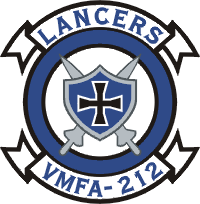
Marine Fighter Attack Squadron 212 (VMFA-212) was a United States Marine Corps F/A-18 Hornet squadron. Most recently known as the "Lancers", the squadron was last based at Marine Corps Air Station Iwakuni, Japan and fell under the command of Marine Aircraft Group 12 (MAG-12) and the 1st Marine Aircraft Wing. VMFA-212 has an extensive combat history having participated in combat operations during World War II, the Korean War, Vietnam War, the Gulf War, and Operation Enduring Freedom. Due to a re-organization within Marine aviation, the squadron was deactivated in 2008.
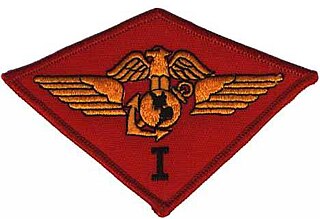
The 1st Marine Aircraft Wing is an aviation unit of the United States Marine Corps that serves as the Aviation Combat Element of the III Marine Expeditionary Force. The wing is headquartered at Camp Foster on the island of Okinawa, Japan. Activated in 1940, the wing has seen heavy combat operations during World War II, the Korean War, and the Vietnam War.
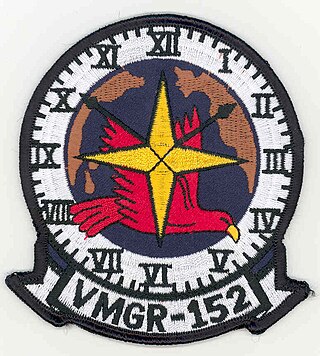
Marine Aerial Refueler Transport Squadron 152 (VMGR-152) provides aerial refueling service to support Fleet Marine Force (FMF) air operations; and provides assault air transport of personnel, equipment, and supplies. The squadron, known as the "Sumos", flies the fixed-wing Lockheed Martin KC-130J aircraft. VMGR-152 is stationed at Marine Corps Air Station Iwakuni, Iwakuni, Japan and is part of Marine Aircraft Group 12 (MAG-12) and the 1st Marine Aircraft Wing.
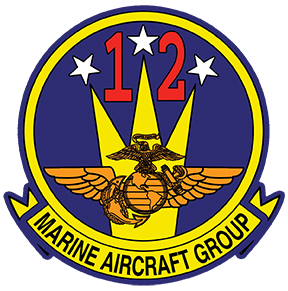
Marine Aircraft Group 12 (MAG-12) is an active air group of the United States Marine Corps, tasked with providing fighter and assault support aircraft. It is currently part of the 1st Marine Aircraft Wing, itself an integral part of the III Marine Expeditionary Force, and based at MCAS Iwakuni in Japan.

Marine Aircraft Group 11 is a United States Marine Corps aviation unit based at Marine Corps Air Station Miramar that is currently composed of two F-35C squadrons, one F-35B squadron, two F/A-18C squadrons, one fleet replacement squadron, one KC-130J tactical aerial refueling squadron, a maintenance and logistics squadron, and a wing support squadron. They fall under the command of the 3rd Marine Aircraft Wing and the I Marine Expeditionary Force.

Marine Medium Tiltrotor Squadron 161 (VMM-161) is a United States Marine Corps tiltrotor squadron that operates the MV-22 Osprey. The squadron, known as the "Greyhawks", is based at Marine Corps Air Station Miramar, California and falls under the command of Marine Aircraft Group 16 (MAG-16) and the 3rd Marine Aircraft Wing. The squadron has the distinction of being the first helicopter transport squadron in the world and regularly utilizes the phrase "The First, The Best".

Marine Aerial Refueler Transport Squadron 352 (VMGR-352) is a United States Marine Corps KC-130J squadron. They are a part of Marine Aircraft Group 11 (MAG-11), 3rd Marine Aircraft Wing and provide both fixed-wing and rotary-wing aerial refueling capabilities to support Fleet Marine Force (FMF) air operations in addition to assault air transport of personnel, equipment, and supplies. The squadron, known as the "Raiders" is stationed at Marine Corps Air Station Miramar, California.

Marine Heavy Helicopter Squadron 462 (HMH-462) is a United States Marine Corps helicopter squadron operating CH-53E Super Stallion heavy transport helicopters. The squadron, known as the "Heavy Haulers", is based at Marine Corps Air Station Miramar in California and falls under the command of Marine Aircraft Group 16 (MAG-16) and the 3rd Marine Aircraft Wing.
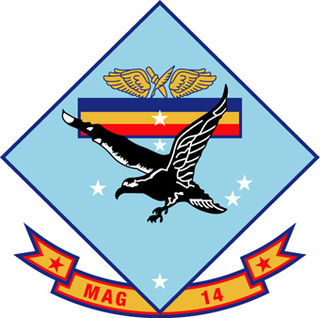
Marine Aircraft Group 14 (MAG-14) is a United States Marine Corps aviation unit based at Marine Corps Air Station Cherry Point, North Carolina that is currently composed of two AV-8B Harrier squadrons, one F-35B squadron, one UAV training squadron, one KC-130 squadron, and an aviation logistics squadron.

Marine Aircraft Group 41 (MAG-41) is a United States Marine Corps reserve aviation unit based at Naval Air Station Joint Reserve Base Fort Worth, Texas that is currently composed of one F/A-18C squadron, one KC-130J squadron, one C-40 squadron, two Northrop F-5 aggressor squadron based at Marine Corps Air Station Yuma, Arizona and Marine Corps Air Station Beaufort, South Carolina, one Marine Light Attack Helicopter Squadron at MCAS Camp Pendleton, one MV-22B squadron based at MCAS Miramar, one aviation logistics squadron and two wing support squadrons with multiple detachments throughout the United States.

Marine Aerial Refueler Transport Squadron 234 (VMGR-234) is a reserve United States Marine Corps KC-130J squadron. They are a part of Marine Aircraft Group 41 (MAG-41), 4th Marine Aircraft Wing and provide both fixed-wing and rotary-wing aerial refueling capabilities to support Marine Forces Reserve air operations in addition to assault air transport of personnel, equipment, and supplies. The squadron, known as the "Rangers" is stationed at Naval Air Station Joint Reserve Base Fort Worth, Texas.

Marine Aerial Refueler Transport Squadron 452 (VMGR-452) was a reserve United States Marine Corps cargo squadron that previously flew the Lockheed Martin KC-130J. The squadron fell under the command of Marine Aircraft Group 49 (MAG-49) and the 4th Marine Aircraft Wing. The squadron, known as the "Yankees", was stationed at Stewart Air National Guard Base, New York.

Marine Aerial Refueler Transport Squadron 252 (VMGR-252) is a United States Marine Corps KC-130J squadron. They are a part of Marine Aircraft Group 14 (MAG-14), 2nd Marine Aircraft Wing and provide both fixed-wing and rotary-wing aerial refueling capabilities to support Fleet Marine Force air operations in addition to assault air transport of personnel, equipment, and supplies. The squadron, known as "Otis" is stationed at Marine Corps Air Station Cherry Point, North Carolina. It also has the distinction of being the oldest continually active squadron in the Marine Corps.
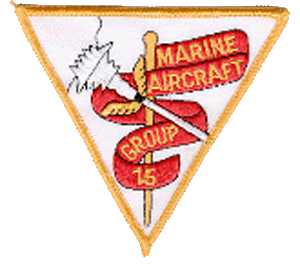
Marine Aircraft Group 15 (MAG-15) was a United States Marine Corps aviation group established during World War II. MAG-15, a transport and photo-reconnaissance training group, was commissioned on 1 March 1942, headquartered at Camp Kearny, San Diego. In addition to radio and photographic training, the Group also conducted a navigation school. Additional roles included West Coast aircraft acceptance and transport service for the Marine Corps.
South Pacific Combat Air Transport Command (SCAT) was a joint command of U.S. military logistics units in the Pacific Ocean theater of World War II. It contributed notably to the success of U.S. forces in the campaigns on Guadalcanal (1942–1943), New Georgia (1943), and Bougainville (1943–1945), as well as the Allied air campaign against Rabaul.

Marine Aircraft Group 49 is a United States Marine Corps Reserve aviation unit based at Joint Base McGuire–Dix–Lakehurst, New Jersey that is currently composed of squadrons that fly the MV-22B, CH-53E, AH-1Z, UH-1Y, UC-35D and UC-12F/W aircraft as well as an Aviation Logistics Squadron and Wing Support Squadron.

Marine Transport Squadron 152 (VMR-152) was an air transport squadron of the United States Marine Corps that was responsible for the movement of personnel, equipment, and supplies. The squadron flew fixed-wing cargo aircraft to include the R4D Skytrain and the R4Q Flying Boxcar. The squadron saw combat during World War II and the Korean War with their most notable contributions coming during the Battle of Guadalcanal and during the Marine breakout during the Battle of Chosin Reservoir. The squadron was decommissioned in the late 1950s.
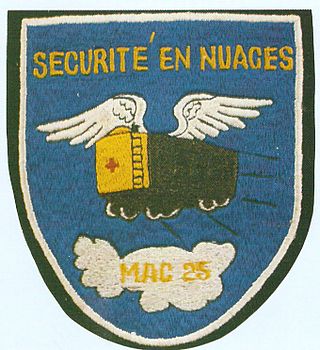
Marine Air Group (MAG) 25 was a United States Marine Corps combat air transport group that provided logistical support, including cargo and personnel transport and aeromedical evacuation, to forward units during World War II and the Korean War. During World War II it formed the nucleus of the South Pacific Combat Air Transport Command.
The 801st Medical Air Evacuation Squadron was a United States Army Air Forces (USAAF) unit that provided aeromedical evacuation and support services to front-line units in the Pacific Theater of World War II. From the latter part of the Guadalcanal Campaign through Operation Cartwheel it was attached to Marine Aircraft Group 25 and the South Pacific Combat Air Transport Command (SCAT).

Marine Composite Reconnaissance Squadron 1 (VMCJ-1) was an aviation squadron of the United States Marine Corps that provided aerial photographic reconnaissance and electronic countermeasures is support of the Fleet Marine Force. The squadron was formed in 1958 with the merger of Marine Composite Squadron 1 (VMC-1) and Marine Photo Reconnaissance 1 (VMJ-1). The squadron's support to the Vietnam War began in 1964 flying off Yankee Station and ended with sorties in support of Operation Frequent Wind during the fall of Saigon. VMCJ-1 was decommissioned in 1975 as the Marine Corps further consolidated its aerial photo reconnaissance assets after the Vietnam War.





















